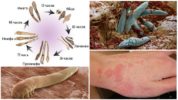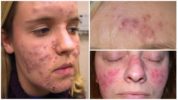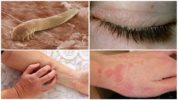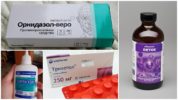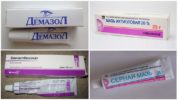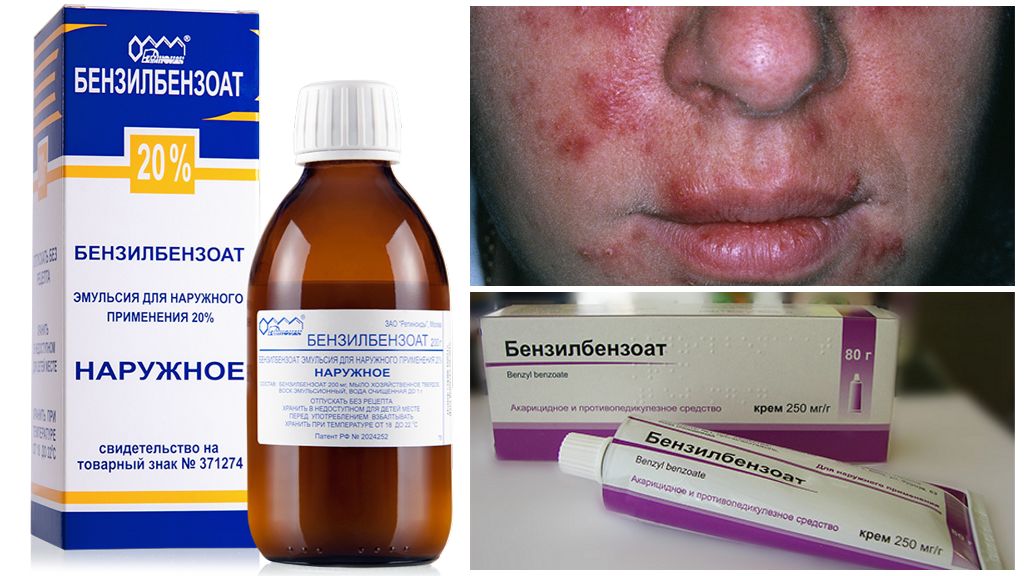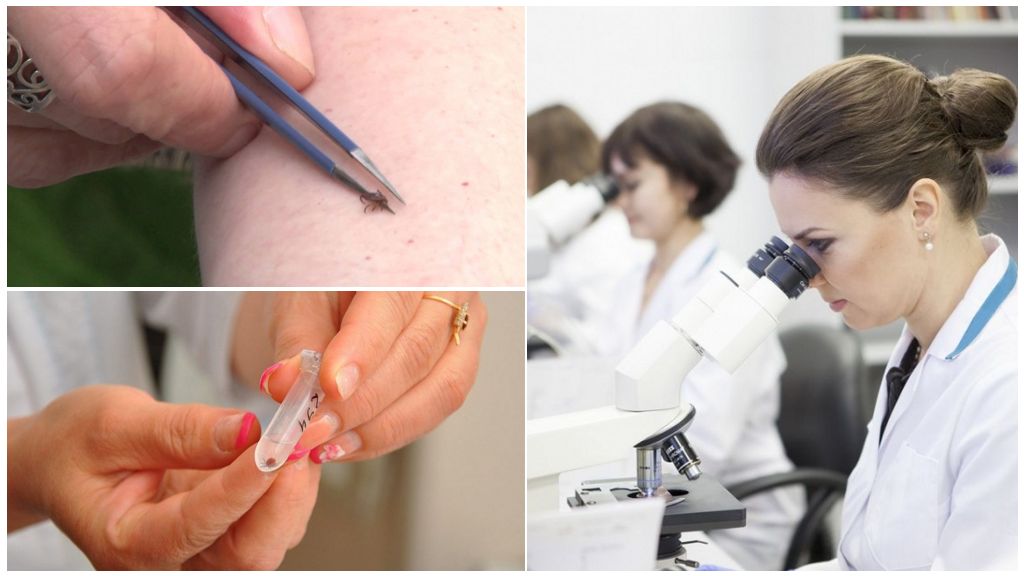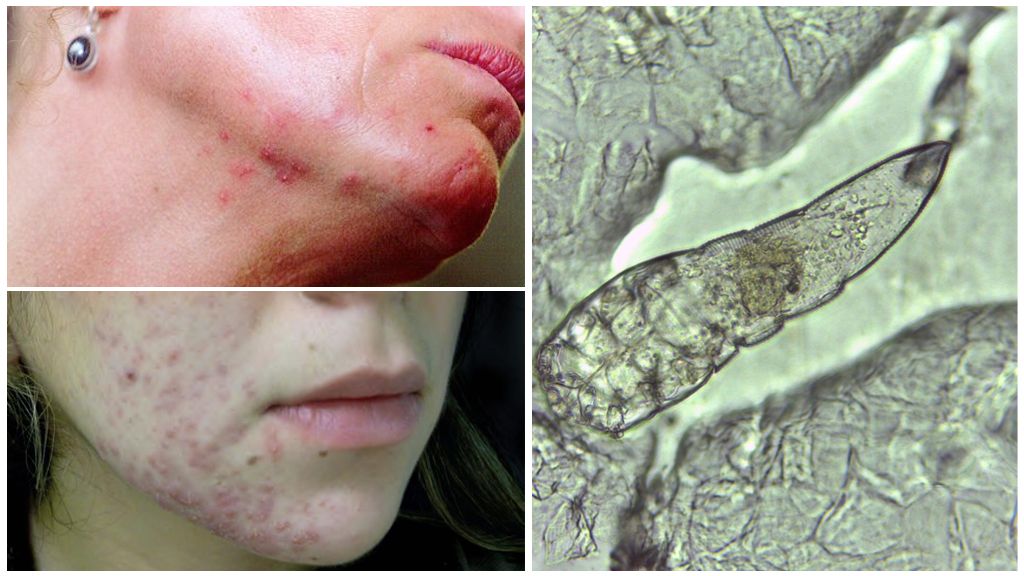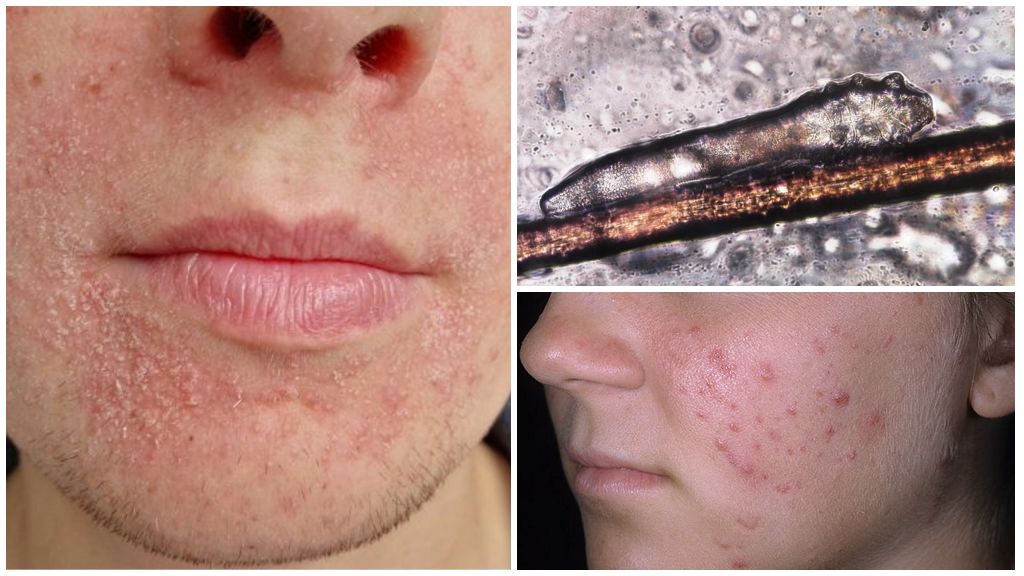- Demodecosis ticks
- Signs of Demodecosis
- Demodecosis on the body
- Preparations for the treatment of demodicosis
- Ointments for the treatment of demodicosis
- Folk remedies for demodicosis
Demodecosis is a skin disease in which a parasitic tick affects the ducts of the sebaceous glands. Information on the causes and external symptoms will help to detect such an unpleasant disease in time and consult a doctor for advice. Successful treatment of demodicosis is possible only with prolonged complex therapy under the supervision of a dermatologist.
What is demodicosis
In addition to medical, the disease has several names at once: "rosacea", that is, like a rose, and "rosacea." All of them are given for the appearance of the affected skin, which looks like a scattering of pink acne. Disfigured zones are clearly distinguished on the skin, in which there is a reddened and thickened layer of the epidermis penetrated by dilated tiny blood vessels called “telangiectasias”, as seen in the photo of the patient’s demodecosis.
Most often, the foci of the disease appear on the face, which leads to cosmetic defects in women who develop demodicosis more often than men aged 30-50. A small number of parasites can also occur on other parts of the body: on the chest, on the back, neck, etc.
Interesting!
“Rosacea” is the most common disease among the population of Ireland and southern Italy, but the inhabitants of the African continent and China suffer from it quite rarely.
Causes of Demodecosis
The causative agents of the disease are microscopic subcutaneous mites 2 types:
- which parasitizes inside the sebaceous glands of Demodex folliculorum;
- in hair follicles of Demodex brevis in humans and mammals.
On a note!
They are sometimes called ciliary mites due to their frequent settlement on the hairs of eyelashes, as well as acne.
The size of an adult parasite is 0.2-0.5 mm, so it is impossible to see them with the naked eye, but only under a microscope. The body of the tick is translucent, has an elongated shape and consists of 2 parts, in front there are 4 pairs of legs for fast movement at a speed of up to 16 mm / h. For eating particles of epithelium and secretion from the sebaceous glands, a spokes-shaped oral apparatus is intended. On the body of the tick there are many scales, with the help of which it is attached to the hair follicle.
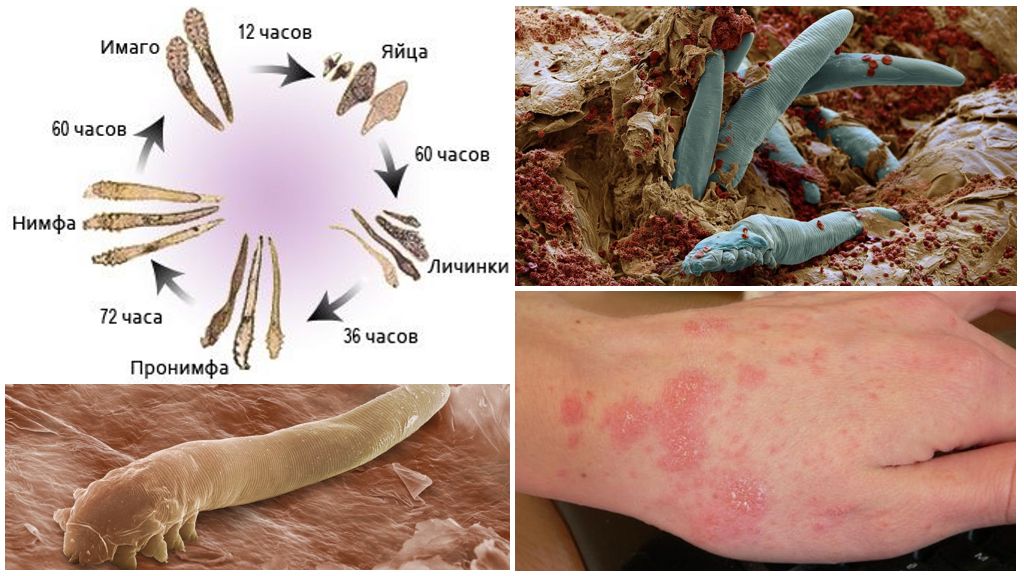
The life cycle of the parasite is several weeks. Reproduction occurs through the laying of 20-25 eggs by the females in the cavity of the hair follicles, of which 6 days later small larvae appear. As they grow over 7 days, they form in adults.
The whole life of demodecosis ticks passes under the upper layer of the epidermis, and they come to the surface exclusively for mating or searching for a new location. Because of photophobia, they lead an active life at night.
The way transmission of demodicosis:
- in contact with a sick or healthy person who is a carrier of demodexes, which according to statistics is 80% of the world's population;
- ticks can remain viable in the environment and survive for some time if released into water.
On a note!
Demodexes are conditionally pathogenic parasites present in the skin of many people. Their reproduction and subsequent clinical signs of the disease usually occur under favorable conditions.
Factors contributing to the development of demodicosis in humans:
- genetic predisposition;
- diseases of the gastrointestinal tract (gastrointestinal tract);
- disorders and diseases in the endocrine system: hormonal imbalance, diabetes mellitus, etc .;
- decreased immunity (after a common cold or due to a long illness);
- negative external factors: nervous stress, overheating in the sun, prolonged use of drugs or hormonal drugs, harmful working conditions, the use of oily cosmetics and allergic reactions, alcohol abuse, poor nutrition.
Symptoms of Demodicosis
The disease manifests itself to varying degrees depending on the number of ticks and their reproduction process, such as the epidermis and the condition of the patient's body.
Features and signs of demodicosis:
- an inflammatory rash on the skin appears in the area of the face, eyelids, less commonly in other parts of the body;
- itching in the affected area, which intensifies in the evening and at night, during a period of increased activity of subcutaneous ticks.
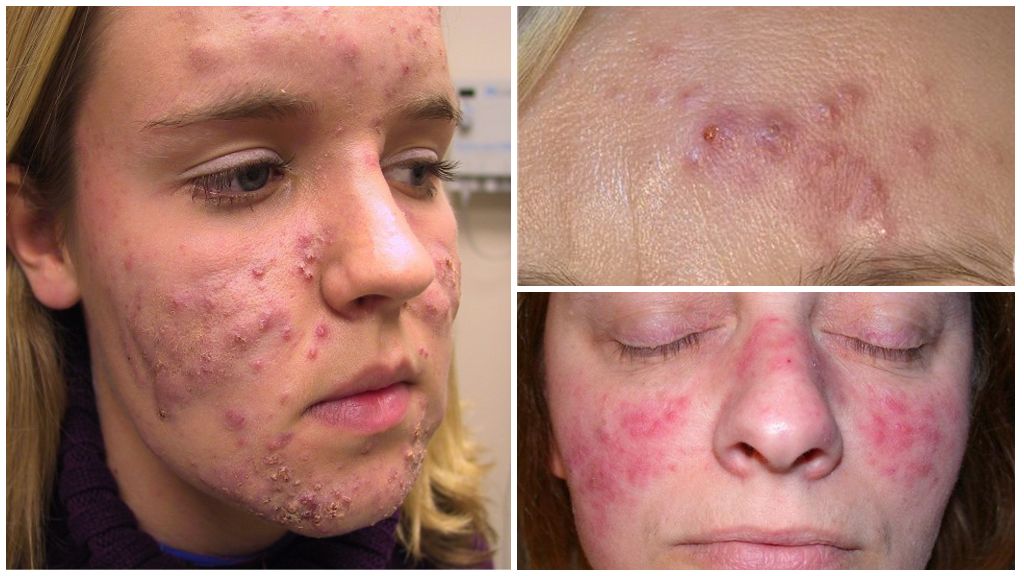
The classification of demodicosis in people, the code according to ICD-10: B88.0, is carried out according to external signs, which determine the stage of the disease:
- The erythematous form is manifested by the appearance of erythema or redness in some areas of the skin: on the face, the rash is localized on the nose and cheeks, its edges are clearly defined and slightly raised. "Vascular spiders" are formed from small vessels, which, when a person is affected, are clearly visible on the lateral parts of the nose and cheeks.
- Papular-pustular stage - characterized by the appearance of acne (papules) and abscesses (pustules) up to 2 mm in size, formed due to overflow of hair follicles with sebum. Clogging of the ducts due to the accumulation of parasites. The color of the formations has shades from pink to red-cyanotic.
- The hypertrophic stage occurs in the absence of treatment, resulting in hypertrophy of the affected areas of the epidermis: pineal growths form on the damaged area, the names of which depend on the affected area (rhinophyma on the nose, metaphyma on the forehead, blepharophyma on the eyelids, otophyma on the earlobe , gnathophymes - on the chin, etc.).
On a note!
Symptoms of demodicosis in children are often disguised as a rash that accompanies adolescence and hormonal changes in the young body. For an accurate diagnosis, you must consult a doctor and make tests for ticks.
Demodecosis in various parts of the body
One of the common areas of damage to this disease is the eyelids and eyes, when the reproduction of ticks occurs in the meibomian glands, i.e., at the base of the eyelashes. The onset of inflammation is usually manifested by severe itching and symptoms of blepharitis, an inflammatory process on the eyelids, it is possible to connect a bacterial infection.
The main sign of eyelid demodicosis is a whitish border at the base of the eyelashes. In the absence of treatment, eyelashes fall out, the edges of the eyelids increase, due to which the patient feels difficulty in closing them.
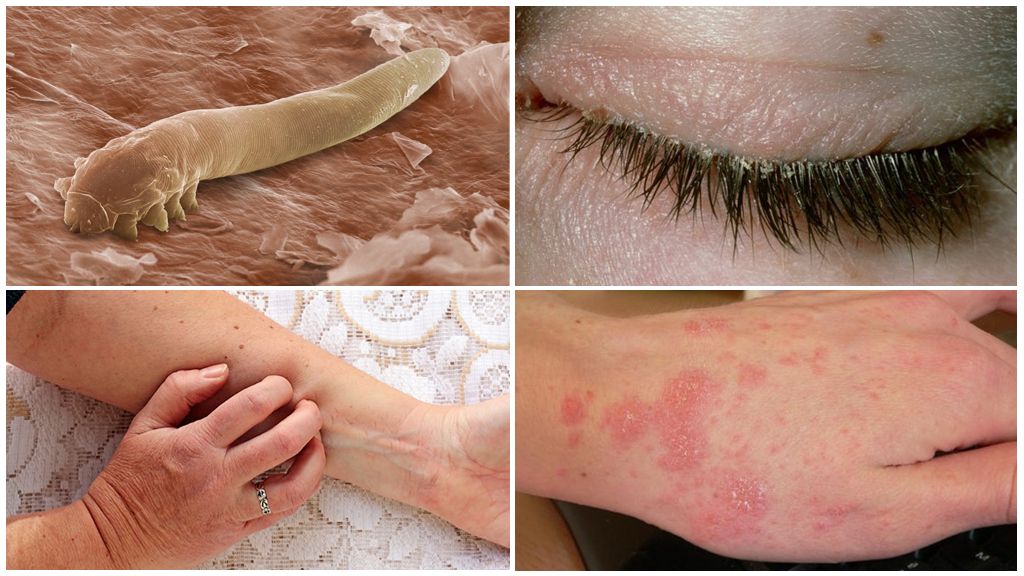
On a note!
Demodecosis of the eyelids in 60% of cases also manifests itself on the face, scalp, can cause complications in the form of chronic conjunctivitis, improper eyelash growth and other diseases.
Demodecosis of the scalp It begins as a result of establishing a favorable environment on its scalp. The disease is rarely detected due to the fact that the appearance of pustules under the hair passes unnoticed by a person. Distinctive symptom: severe itching in the evening. Appeared skin seals can be palpated by palpation of the head.
Demodecosis on the arms, chest and back, neck can appear with a strong reproduction of ticks and the spread of the disease to other parts of the upper half of the body. It is accompanied by sensations of skin tightening, itching and burning in the affected areas. However, this happens very rarely due to the different structure and functioning of the sebaceous glands on the human body, as a result of which demodexes do not find nutrition in them.
Diagnosis of demodicosis
If the characteristic symptoms of the disease are manifested, you should contact your doctor for examination and an accurate diagnosis, which can only be confirmed after receiving analysis from the affected area of the skin and subsequent laboratory testing. Such a scraping the patient passes in a leather clinic or in a private laboratory.
Important!
Before surrender analysis for demodicosis within 2 days you can not use cosmetics and do not wash your skin to get accurate results.
Under the microscope, biological material is examined for the presence of demodex mites, their eggs or larvae. The diagnosis of demodicosis is made, if per 1 square. 5 adult ticks were found per cm of skin; for diseases of the eyelids, at least 6 parasites are present on the 1st eyelash.
How to treat demodicosis
Modern medicine presents many effective tools and drugs to cure such an unpleasant disease. After confirming the diagnosis of demodicosis, the dermatologist determines the treatment regimen, which consists of complex therapy in several directions:
- The use of topical preparations (ointments, creams, sprays).
- Systemic medicines to improve immunity and treat concomitant chronic diseases.
- A program to cleanse the gastrointestinal tract and the entire patient's body.
- Antibiotics and antiparasitic agents for killing ticks: Trichopolum (tablets, price 100 rubles), Ornidazole (capsules and tablets, price 120-160 rubles), Metronidazole (candles, ointment, tablets, price 20-150 rubles), course 10- 15 days. These drugs are contraindicated in pregnant and lactating women, kidney patients, epilepsy.
- Antihistamines to relieve possible allergic reactions.
- Antiseptic solutions for rubbing the skin: Chlorhexidine, Urotropin, Hydrogen Peroxide, Alcohol tincture of calendula, etc.
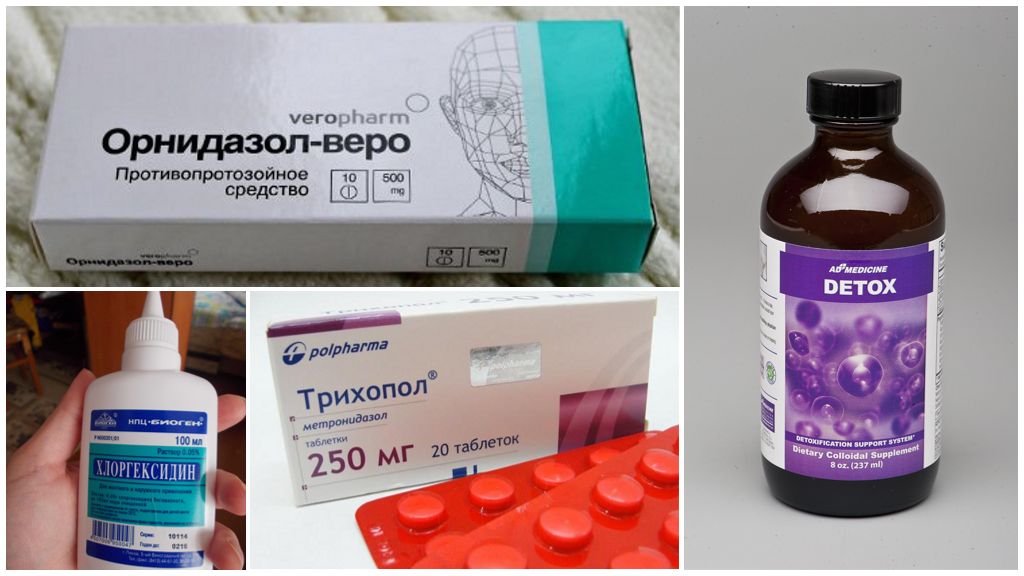
System tools include:
- immunomodulating drugs: Detox (price from 1950 rubles);
- Sodium thiosulfate - has an antiparasitic and anti-inflammatory effect, destroys subcutaneous ticks, the cost of ampoules for injection is 80-100 rubles;
- complexes of vitamins, minerals, amino acids.
Important!
Local skin treatment is carried out in several courses with interruptions, it takes a long time to be treated: from 4-6 weeks to 12 months. The maximum positive effectiveness, according to patients, is provided by ointments and creams, which include drying and anti-decongestants: sulfur, tar, zinc, mercury, etc. They have a blocking effect on the respiratory organs of ticks, which leads to their death.
The most popular ointments:
- Sulfur, price 20-50 rubles .;
- Ichthyol, price 80-120 rubles .;
- Yellow mercury (about 670 rubles);
- Ointments containing metronidazole are among the most effective drugs: Klion (350-400 rubles), Metrogil (180 rubles);
- Benzyl benzoate- a cream with keratolytic antiparasitic and analgesic effect, destroys ticks after the first application, however, treatment should be repeated after 3 days to get rid of young individuals emerging from eggs, price 20-50 rubles .;
- Spregal - an aerosol that causes the death of acne and its eggs, is sprayed on the damaged areas 1 time before bedtime, it is recommended to apply on the face with a swab, repeat the treatment after a few days, the price is 980 rubles .;
- Demalan - a cosmetic antiparasitic agent, is used to treat demodecosis on the face and eyelids, the price is 400 rubles .;
- Azogel - a drug containing azelaic acid, which has an anti-inflammatory, antiparasitic effect, helps restore normal functioning of the sebaceous glands; price 400-700 rubles .;
- Demazole - an anti-inflammatory cream that improves regenerative and metabolic processes in the affected areas of the skin; price 250 rub .;
- Crotamiton - applied after a shower, highly effective against ticks, helps relieve itching and remove inflammation, price 1400 rubles .;
- Cosmetic gel Stop Demodex - used to get rid of ticks in the eyes and eyelids, relieves itching, swelling and inflammation, restores skin, the price is in the range of 180-225 rubles.
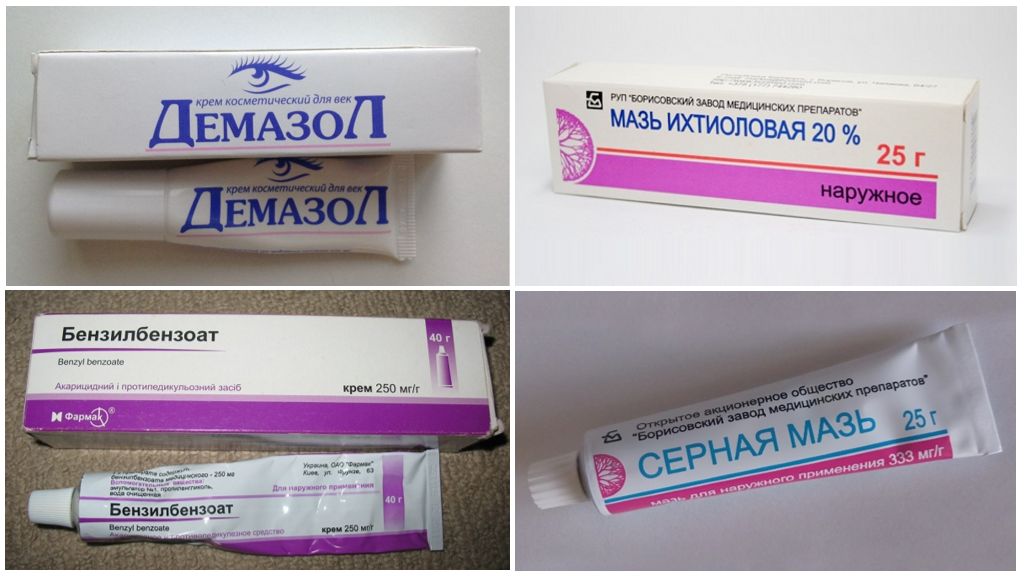
Body cleansing and elimination of toxins
When treating demodicosis at home, it is recommended that therapy be observed with a special diet and the use of medications to remove toxins and cleanse the digestive tract.
Dietary nutrition involves a complete rejection of flour, sweet, fatty, smoked, and fried foods. It is recommended to consume more vegetables and fruits, cereals (oatmeal, etc.), drink clean water 1.5-2 liters per day. This will relieve the patient’s body and create adverse living conditions for ticks.
On a note!
GIT cleansing is carried out using absorbent preparations: Activated Carbon, Enterosgel, Smecta, Polysorb, etc. They will help remove toxins and toxins after the vital activity of parasites.
Treatment of demodicosis with alternative methods
Therapy with folk remedies It takes place in stages: first, the immune system is restored, then the suppression of the negative effects of ticks is carried out, and then the skin needs to be restored and improved by improving its protective properties.
Herbal infusions for oral administration:
- make a mixture of herbs from 1 part of the leaves of plantain, 1 - wormwood, 1 - mint, 1 - yarrow, 1 - tansy flowers, 2 - succession, 1 - nettle; for cooking take 2 tbsp. l of the mixture, pour 500 ml of boiling water and insist 30 minutes, closing the lid; drink 0.5 tbsp. three times a day before meals, course - 4-6 weeks;
- a mixture of 2 parts of violet, 2 - flowers of calendula, 2 - St. John's wort, 1 - mint leaves and 1 - plantain, 1 - elecampane roots; the drink is prepared from 2 tbsp. l of the mixture, which must be poured with boiling water and infused for 30 minutes., Filter, drink in the same way.

Recipes for external remedies for demodicosis:
- Prepare aloe juice and dilute with water in a 1: 1 ratio, wet a napkin and put on affected skin for 15 minutes. The duration of treatment is 20-25 procedures, done every other day.
- Decoction of 2 tbsp. l of lime color and 1 tbsp. boiling water, hold on a steam bath for 10 minutes, after straining, apply to wipe the skin twice a day, after the procedure you can not go out in the cold.
- Compresses from the juice of ripe tomatoes are done daily for 15 minutes, the course is 20 days.
- Veterinary application ointments Yam.
- 1-2 tbsp. l dry chamomile for 1 tbsp. hot water, boil for 10 minutes, filter, compresses alternately with cold and hot broth 2-3 r. in Week.
- Grind 1 tbsp. l juniper berries, pour 1 tbsp. boiling water, insist 4-6 hours, strain. Apply for lotions 1-2 times a day for 15-20 minutes, pre-wipe the skin with tincture of calendula or eucalyptus.
- Prepare a mass of 100 g of tansy and 400 ml of vegetable oil, insist for 14 days, filter, use in the form of warm compresses 1-2 times daily.
- Grind to a powdery state 3 tbsp. l wormwood, steam, add 1 tsp honey, 1 tsp alum, 1 tbsp. l vegetable oil, 2 tbsp. l crushed berries of viburnum (seedless), mix everything. Apply the obtained ointment to cuts of cotton tissue and apply to the affected areas 1-2 times a day for 2 hours. Pre-wipe the skin with glycerin solution: 1 tsp per 1 tbsp. water. After removing the lotion, wash with salt water (0.5 tsp of salt per 1 tbsp.).
Demodecosis Prevention
There are a number of rules and recommendations that must be followed during treatment in order to get rid of demodicosis forever and prevent relapse of the disease:
- monitor the cleanliness of personal hygiene items and bedding, change during the treatment period daily, boil or iron;
- for the period of therapy, refuse to use cosmetics, trips to baths and saunas, sunbathing and a solarium;
- in order to prevent the recurrence of an unpleasant disease, it is recommended to carry out cosmetic and cosmetic procedures at the stage of remission: microdermabrasion, that is, removal of the upper layers of the skin along with ticks; non-hardware facial cleansing or peeling;
- preventive laser therapy is recommended in areas with a vascular network, which will help normalize metabolic processes in the epidermis;
- change in diet to reduce oily skin.
To successfully cure demodicosis, you should tune in to a long therapeutic process, which depends on the stage and severity of the disease. Patient reviews and a positive prognosis of specialists allow the patient to hope for a full recovery.
